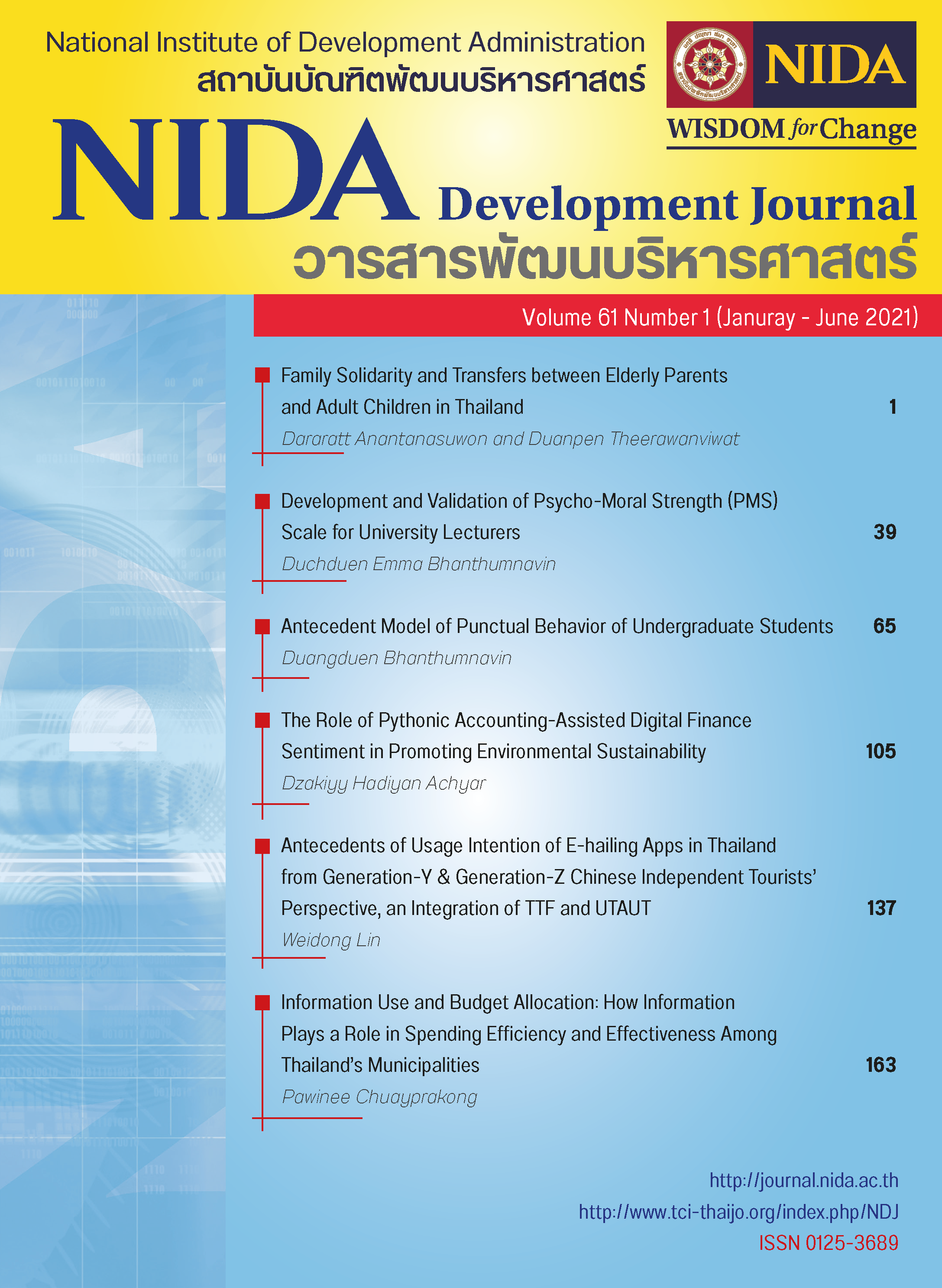The Role of Pythonic Accounting-Assisted Digital Finance Sentiment in Pro-moting Environmental Sustainability
Keywords:
Python, Pycharm, Carbon, Polarity, SentimentAbstract
This panel data study aims to examine the relationship between Indonesia’s environmental protection achievement in terms of climate change prevention and its prevailing political economy by explicitly considering the role of pythonic accounting assisted-capital market sentiment from 2001 to 2018. This study uses fixed and random-effect models as econometric techniques. Environmental protection is measured by Indonesia Environmental Carbon Index. The political economy is measured by the wealth distribution index among Indonesians or known as the GINI coefficient. This study concludes with two important findings: (1) The Government of Indonesia’s politically motivated economic policies resulting in wealth distribution inequalities significantly harm the environmental protection effort mostly in carbon emission control and waste management. Economic inequalities resulting from the politically motivated economic policy indirectly legitimize people’s action to exploit nature by any means necessary to survive. Therefore, the fifth state principle of Pancasila mandating social justice for every single Indonesian can be the best explanation for this social jealousy phenomenon. In other words, environmental protection without fair political economy policies is an impossible mission; (2) media sentiment on digital finance shows an insignificant impact only during the first two presidencies 2001-2008 on the relationship between the wealth distribution gap and environmental protection in Indonesia. Meaning that speculations or reactions from the media related to digital finance could not do anything about the existing wealth distribution gap's impact on the environmental protection effort in Indonesia in the early 2000s but it starts to change after 2005 in Indonesia due to capital market maturity after Asia economic crisis 1998-1999.
References
Acemoglu, D. (2021). AI’s future doesn’t have to be dystopian. Boston Review.
Agung, J. (2003). FINANCIAL STRUCTURE, FIRMS’ INVESTMENTS AND THE CHANNELS OF MONETARY POLICY IN INDONESIA. Buletin Ekonomi Moneter Dan Perbankan, 3(1), 146–178. https://doi.org/10.21098/bemp.v3i1.291
Ahmed, N., Marriott, A., Dabi, N., Lowthers, M., Lawson, M., & Mugehera, L. (2022). Inequality Kills: The unparalleled action needed to combat unprecedented inequality in the wake of COVID-19. Oxfam. https://doi.org/10.21201/2022.8465
Alkhwaldi, A. F., Alharasis, E. E., Shehadeh, M., Abu-AlSondos, I. A., Oudat, M. S., & Bani Atta, A. A. (2022). Towards an Understanding of FinTech Users’ Adoption: Intention and e-Loyalty Post-COVID-19 from a Developing Country Perspective. Sustainability, 14(19), 12616. https://doi.org/10.3390/su141912616
Andaiyani, S., & Falianty, T. A. (2017). ASEAN CREDIT GROWTH AND ASSET PRICE RES PONSE TO GLOBAL FINANCIAL CYCLE. Buletin Ekonomi Moneter Dan Perbankan, 20(2), 203–228. https://doi.org/10.21098/bemp.v20i2.812
Anghelache, C. (2014). Using the regression model for the portfolios analysis and management. 14.
Anifa, M., Ramakrishnan, S., Joghee, S., Kabiraj, S., & Bishnoi, M. M. (2022). Fintech Innovations in the Financial Service Industry. Journal of Risk and Financial Management, 15(7), 287. https://doi.org/10.3390/jrfm15070287
Asian Development Bank. (2017). Accelerating Financial Inclusion in South-East Asia with Digital Finance. Asian Development Bank and Oliver Wyman. https://doi.org/10.22617/RPT178622-2
Atkinson, A. B., Piketty, T., & Saez, E. (2011). Top Incomes in the Long Run of History. Journal of Economic Literature, 49(1), 3–71. https://doi.org/10.1257/jel.49.1.3
Chamlongrath, W., & Tingsabhat, C. (2021). The Payment Behavior and Electronic Payments Usage of University Students. 14.
Feng, C., Li, L., & Sadeghpour, A. (2020). A comparison of residual diagnosis tools for diagnosing regression models for count data. BMC Medical Research Methodology, 20(1), 175. https://doi.org/10.1186/s12874-020-01055-2
Hardoon, D., Fuentes-Nieva, R., & Ayele, S. (2020). An Economy For the 1%: How privilege and power in the economy drive extreme inequality and how this can be stopped. 44.
Heteroscedasticity and Homoscedasticity. (2007). In N. Salkind, Encyclopedia of Measurement and Statistics. Sage Publications, Inc. https://doi.org/10.4135/9781412952644.n201
Moreira-Santos, D., Au-Yong-Oliveira, M., & Palma-Moreira, A. (2022). Fintech Services and the Drivers of Their Implementation in Small and Medium Enterprises. Information, 13(9), 409. https://doi.org/10.3390/info13090409
Nafees, M., Dar, H., Lali, I. U., & Tiwana, S. (2018). Sentiment Analysis of Polarity in Product Reviews In Social Media. 2018 14th International Conference on Emerging Technologies (ICET), 1–6. https://doi.org/10.1109/ICET.2018.8603585
Pepinsky, T. B. (2013). Development, Social Change, and Islamic Finance in Contemporary Indonesia. World Development, 41, 157–167. https://doi.org/10.1016/j.worlddev.2012.06.007
Piketty, T. (2014). Capital in the Twenty-First Century. 674.
Rodrik, D., & Sabel, C. F. (2019). Building a Good Jobs Economy. SSRN Electronic Journal. https://doi.org/10.2139/ssrn.3533430
Saez, E., & Zucman, G. (2020). Wealth Inequality in the United States since 1913: Evidence from Capitalized Income Tax Data. 65.
Sanz-Sanz, J. F. (2022). A full-fledged analytical model for the Laffer curve in personal income taxation. Economic Analysis and Policy, 73, 795–811. https://doi.org/10.1016/j.eap.2022.01.008
Setiawan, B., Nugraha, D. P., Irawan, A., Nathan, R. J., & Zoltan, Z. (2021). User Innovativeness and Fintech Adoption in Indonesia. Journal of Open Innovation: Technology, Market, and Complexity, 7(3), 188. https://doi.org/10.3390/joitmc7030188
Sufian, F., & Habibullah, M. S. (2021). FINANCIAL CRISIS, IMF, AND BANK EFFICIENCY: EMPIRICAL EVIDENCE FROM THE ASEAN-4 BANKING SECTORS. 28.
Tama, I. P., Nugroho, W. S., Mahmudy, W. F., & Purnami, P. (2022). The Evaluation of Technology Startup Role on Indonesian SMEs Industry 4.0 Adoption Using CLD-ABM Integrated Model. Sustainability, 14(14), 8462. https://doi.org/10.3390/su14148462
Thathsarani, U. S., & Jianguo, W. (2022). Do Digital Finance and the Technology Acceptance Model Strengthen Financial Inclusion and SME Performance? Information, 13(8), 390. https://doi.org/10.3390/info13080390
Turóczy, Z., & Marian, L. (2012). Multiple Regression Analysis of Performance Indicators in the Ceramic Industry. Procedia Economics and Finance, 3, 509–514. https://doi.org/10.1016/S2212-5671(12)00188-8
Varma, P., Nijjer, S., Sood, K., Grima, S., & Rupeika-Apoga, R. (2022). Thematic Analysis of Financial Technology (Fintech) Influence on the Banking Industry. Risks, 10(10), 186. https://doi.org/10.3390/risks10100186
World Bank. (2016). World Bank East Asia and Pacific Economic Update, October 2016: Reducing Vulnerabilities. World Bank. https://doi.org/10.1596/25088
Zucman, G. (2014). Taxing across Borders: Tracking Personal Wealth and Corporate Profits. Journal of Economic Perspectives, 28(4), 121–148. https://doi.org/10.1257/jep.28.4.121
Downloads
Published
How to Cite
Issue
Section
License
Copyright (c) 2023 NIDA Development Journal

This work is licensed under a Creative Commons Attribution-NonCommercial-NoDerivatives 4.0 International License.





